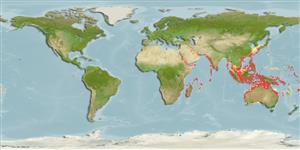Environment: milieu / climate zone / depth range / distribution range
Ecología
marino asociado a arrecife; rango de profundidad 2 - 95 m (Ref. 55723), usually ? - 25 m (Ref. 42181). Tropical
Indo-West Pacific: East Africa to Papua New Guinea, north to Taiwan (Ref. 11441) and the Philippines, south to the Great Barrier Reef (Ref. 33390). Also reported from the Saya de Malha Bank (76-95 meters) (Ref. 55723).
Tamaño / Peso / Age
Maturity: Lm ? range ? - ? cm
Max length : 25.0 cm TL macho / no sexado; (Ref. 48635)
Espinas dorsales (total): 12; Radios blandos dorsales (total): 9; Espinas anales 3; Radios blandos anales: 5. Adults are best recognized by the tiny light-blue ocelli scattered over the body, and dark triangle below the eye. Small juveniles have three distinctive white spots along the back (Ref. 48635). A deep quadrangular occipital pit, its anterior edge, as viewed dorsally, with a slight ridge. A low ridge on each side of pit between tympanic and parietal spines. Pectoral rays strongly modally at 17 (Ref 42181).
Inhabits coastal reefs (Ref. 9710); usually taken by diving in protected areas of bays or lagoons, often where the fish can be well camouflaged in areas of algae, seagrass or sponge (Ref. 42181, 48635). Venomous spines. Occurs along continental margins or islands associated with continents, not at true oceanic islands (Ref 90102).
Life cycle and mating behavior
Madurez | Reproducción | Puesta | Huevos | Fecundidad | Larva
Randall, J.E., G.R. Allen and R.C. Steene, 1990. Fishes of the Great Barrier Reef and Coral Sea. University of Hawaii Press, Honolulu, Hawaii. 506 p. (Ref. 2334)
IUCN Red List Status (Ref. 130435)
Human uses
Más información
Nombres comunesSinónimosMetabolismoDespredadoresEcotoxicologíaReproducciónMadurezPuestaAgregación para la puestaFecundidadHuevosEgg development
ReferenciasAcuiculturaPerfil de acuiculturaRazasGenéticaElectrophoresesheritabilidadEnfermedadesProcesamientoNutrientsMass conversion
ColaboradoresImágenesStamps, Coins Misc.SonidosCiguateraVelocidadTipo de nataciónSuperficie branquialOtolitosCerebrosVisión
Herramientas
Special reports
Download XML
Fuentes de Internet
Estimates based on models
Preferred temperature (Ref.
123201): 24.5 - 29, mean 28 °C (based on 766 cells).
Phylogenetic diversity index (Ref.
82804): PD
50 = 0.5000 [Uniqueness, from 0.5 = low to 2.0 = high].
Bayesian length-weight: a=0.01259 (0.00606 - 0.02615), b=3.03 (2.86 - 3.20), in cm total length, based on LWR estimates for this (Sub)family-body shape (Ref.
93245).
Nivel trófico (Ref.
69278): 4.2 ±0.8 se; based on size and trophs of closest relatives
Resiliencia (Ref.
120179): Medio, población duplicada en un tiempo mínimo de 1.4-4.4 años (Preliminary K or Fecundity.).
Fishing Vulnerability (Ref.
59153): Low vulnerability (15 of 100).
Nutrients (Ref.
124155): Calcium = 59 [31, 117] mg/100g; Iron = 0.683 [0.366, 1.639] mg/100g; Protein = 18 [16, 20] %; Omega3 = 0.223 [0.101, 0.607] g/100g; Selenium = 31.6 [17.1, 77.8] μg/100g; VitaminA = 201 [70, 540] μg/100g; Zinc = 1.22 [0.84, 1.75] mg/100g (wet weight);
